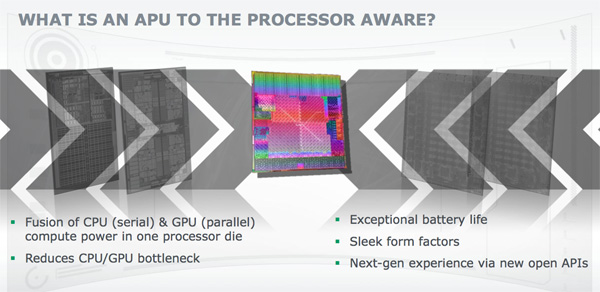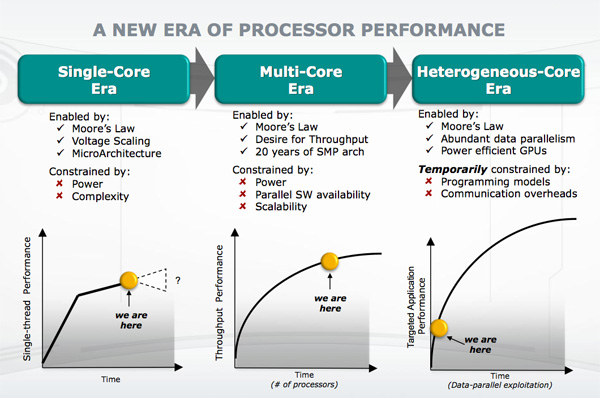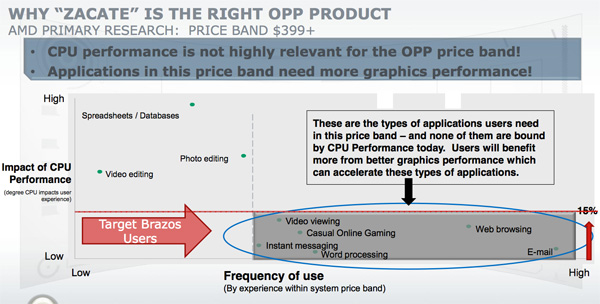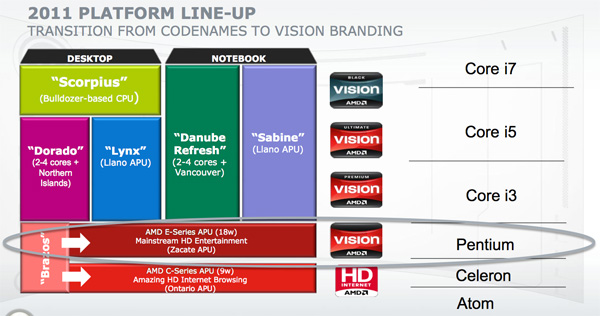Previewing AMD's Brazos, Part 1: More Details on Zacate/Ontario and Fusion
by Anand Lal Shimpi on November 9, 2010 1:09 AM ESTI hate to keep things from you all, but last week I was diligently working in a room at AMD’s new campus in Austin, Texas. You see, AMD wanted to give us more time with the Brazos/Zacate platform we tested at IDF ahead of its official launch. It’s too early for production worthy OEM systems and AMD wasn’t too keen on these reference platforms leaving its offices so it did the next best thing: fly us out to test the systems on AMD’s campus.
The rules were simple. We couldn’t run anything that would harm the system, but other than that we were free to bring whatever we wanted and test however we wanted. AMD dropped by our private room to check to see if we needed anything but other than that, it was all hands off.

The Brazos test platform
While I’d love to share performance data with you today, I can’t. You’ll have to wait another week or so for that. What AMD is allowing us to talk about are the specific configurations AMD’s first Fusion APUs will ship in and general impressions from the testing. Specific benchmarks are off limits unfortunately.
The platform felt final as far as stability goes. I didn’t encounter any crashes during my several hours of non-stop testing. Performance is also indicative of what will ship early next year. The system felt quick (very 11-inch MacBook Air like if you catch my drift) but you have to keep in mind that Zacate and its lower powered sibling Ontario will be used in systems priced between $299 - $549.














106 Comments
View All Comments
flyck - Tuesday, November 9, 2010 - link
Don't forget the chip is manufactured on 40nm. I believe ontario platform released will be ok for the current market. The GF 28nm node for the next models will be the thing that will make ontario succeed or fail.Dark_Archonis - Tuesday, November 9, 2010 - link
By the time the next models on 28mm come out, Atom will be redesigned for out-of-order execution, and ultra low voltage Ivy Bridge models will likely be on sale at the low-end.mino - Tuesday, November 9, 2010 - link
Cheap Ivy Bridge, powerful yet low power Intel IGP, ... Atom faster that Bobcat ...I do not know what you are smoking, but it must be good.
There will be no cheap low power IB. Well, not before 2013.
Ontario #2 is here Q1 2012. How about that.
/end troll reply
Dark_Archonis - Tuesday, November 9, 2010 - link
Ontario #2 will be here Q1 2012? Really? Is that the one on the 28nm process? Somehow I doubt that AMD will release it at that time.Point is, I wouldn't be so sure of Bobcat being a huge success. Let's wait and see what happens shall we?
mino - Tuesday, November 9, 2010 - link
Yes, the 28nm one.Bobcat is the right design for the right market at the right time (even pulled in quarter!) for a great price.
There is possibly no way for it to not succeed. The question remains, how much.
Dark_Archonis - Tuesday, November 9, 2010 - link
Low-end laptops mostly use Celerons and Pentiums. I don't see Bobcat changing that situation much.Bobcat could do well with netbooks, except there is a problem. Netbook market share is declining, mainly due to the iPad.
So in reality, Bobcat has to compete not just with Intel, but also with Apple.
The only other viable market might be the HTPC market. That is not a very big market though, and Intel is pushing hard in that market as of now.
sprockkets - Tuesday, November 9, 2010 - link
Why? The whole point of atom is ultra low power usage in devices like phones where ARM dominates.Never going to happen.
Kiijibari - Tuesday, November 9, 2010 - link
You forget the fundamentally difference between Atom and Bobcat:Bobcat is a OoO CPU, Atom is a InOrder CPU.
Therefore Bobcat will have a much higher performance per clock. If 500 Mhz clock advantage is enough for Atom to beat Bobcat has to be seen.
You might compare that to the i5-760 vs. Phenom2 955/965 situation. Even though the Phenoms run at higher clocks, they are not faster as the lower clocked i5. That's because the i5 has a higher IPC, too. In that case not because of OoO <> InO, but that doesn't matter for the comparison.
mino - Tuesday, November 9, 2010 - link
Actually we have a wery good comparison available right on the market. It is even hinted in the article.Just take 1,3GHz CULV C2D, pair it with a lower clocked 5450 and we are in the ballpark of 18W ontario give or take 10%.
Now we just need to remember where Atom stands relative to C2D ...
Dark_Archonis - Tuesday, November 9, 2010 - link
Atom will improve, Intel won't be sitting still.